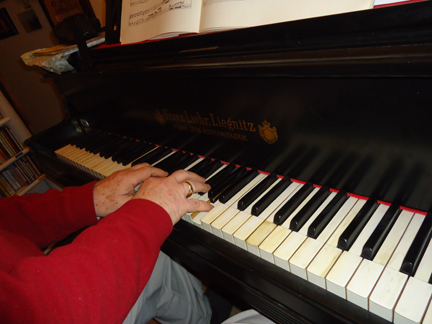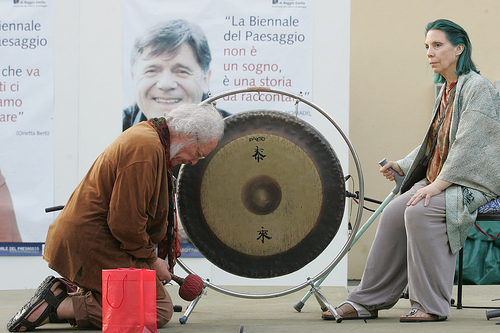PHILIP CORNER

Philip Corner at the piano. Reggio Emilia, Italia, 2011. photo by Daniel Varela
Different Sounds of Silence
by Daniel Varela
(February 2012)
Since John Cage, there has existed a lot of speculations about sound experience and silence. For many people, Cage has been the first (or at least, most significant) artist who remarked about the important role of silence in the field of music. However, Philip Corner (born Bronx, NY, 1933) is working with the concept and experience of silence for more than fifty years, across his extensive catalogue of works. Corner is well-known as an experimental composer from the post-Cage generation (sometimes under the stereotype of a Fluxus artist). But it must be said that even under some Cageian influence, Corner has developed an enormous and personal body of work with plenty of complex and rich influences, as well as studies and discoveries in which is possible to find links between art history, philosophy and a deep knowledge about non-Western cultures and a passion for classic European Architecture and arts. In 1952, Cage wrote "4'33''" and a sound revolution was created without writing any musical note1. His conceptual research included ancient forms of contemplative experiences, even dealing with nothingness or "blank- mind states" – at least in our Western urban understanding but found in spiritual traditions like Zen Buddhism or in Meister Eckhart's (1260 – 1327) work. Corner became part of the younger generation after Cage and the New York School, but since his adolescence, he has been exposed to a lot of different cultural and art influences. In fact, Corner studied in Paris with Olivier Messiaen in 1955 (also in Columbia University with Otto Luening and Henry Cowell) where he studied the great tradition of French baroque masters like Couperin.
It is true that Corner was long involved in Fluxus activities, but since his early compositional period, he has been engaged with an open-minded approach beyound the obvious and also he has been aware of remarkable concepts that were usually ignored throughout the years. In a recent e-mail interview, Corner said that the first silent piece in music history was actually inside a romantic oeuvre: "The first actually written silence is "Sphinxes" in Schumann's 'Carnaval'"2. "Sphinxes" might well be classified as conceptual music long before that term was coined because "Carnaval" was written by Schumann between 1834 and 1835. It consists of three one-beat sections, including four, three and four notes in a square figure, without tonality, tempo or dynamic indication, generally omitted in concerts or recordings. It could be said that another landmark about silence in the context of art was the pre-dadaist Marche Funebre Composee pour les Funerailles d'un Grand Homme Sourd of 1897, written by Frechman Alphonse Allais and In Futurum (1919) by Czech composer Erwin Schulhoff as part of his Funf Pittoresken for piano.
Corner knew about the historical evolution of silent pieces and went beyond "Cage discovering," making a sort of creative dialogue or discussion in which he developed a very personal voice. His exposure to Korean culture in the late fifties - during the period of his military service – gave him his first stimuli about sound contemplation and he developed a deep attention to sound events which were usually inadvertent.
In 1983, Philip Corner gave a lecture at Berlin Technische Universitat entitled "Some Silences," a series of concepts on silence that was a point of departure for decades of investigations and text–scores until today. In its original form, Corner thought that the speech lasted one hour and a half and he started it with a sort of Cagean sentence: "listen to sounds around – what" and the following "complete experience. Speak about only after". Each verse was an instruction, which was more like a proposal with varied degree of determinacy or openness which offer varied forms of experience. Some of them were more explicit while others were more elusive, but always with a sense of invitation: "The mind is to be specifically directed. But non compulsively. Hence the avoidance of the command form so often encountered in verbal scores (Do this!)" 3.
Focused on breath or the perception of surrounding details, "Some Silences" offers the capability to "build up to emotional climaxes" and instructions – like silence number 21, "listen (they're only in your ears)." Since that 1983 conference, a lot of silent series were collected and added by Corner arriving to rhetorical or philosophical categories, like"think about some problems… the problem." 4
But it is also possible to trace a story before such investigations. It was around the late '60's when Corner documented his philosophical walking journeys, opening his ears to the world much before other similar experiences by other artists (like those by German- Canadian Hildegard Westerkamp, also influenced by 'sound meditations' concepts by Pauline Oliveros). I Can Walk Through the World as Music is a collection of thoughts, wanderings and sound discoveries across Central Park in New York, making a different sort of space open to nature but at the same time, to the inner world.
Sounds out from Silent Spaces was another interesting part of Philip Corner's silent experiences. In 1972, he funded a sort of workshop with his then-wife, astrologer and medium Julie Winter, promoting sound contemplation in nature without rigid preconceived forms and focused on the process of being receptive to surroundings sounds as much as being attentinve to the inner self.
Sharing some similiarities with the Cagean world (and even with Oliveros' 'deep listening' concepts) , Sound out from Silent Spaces was part of Corner's creative universe until its final meetings in 1979. The focused attention to sounds from the environment could be a meditative and introspective process, which was dealing with sound in a deep process with internal awareness. Corner explains this recently as this kind of process:"opening by the presence of outside world, playing with natural objects, free improvisation; pass to more concentrated formalization; Group chanting focussing down to one note; The (20 minutes of) silence; Reopening with some rhythmic forms; End with physical spontaneity." 5
Another series of near- silence listenings were done in 1977. This time, it was with a common denominator- water as primal materia. Ear Journeys: Water is a collection of cards that could look like Zen haikus or Fluxus scores driving to a more sensitive and conscious contact with such vital elements. This included careful listening of different water streams, alternating perception of natural fluids in both ears, varied locations for original phenomena of the same water source- the liquid element ever flows as soon as the mind. It was physical and meditative at the same time.
Silence is part of Corner's work across time, in different pieces and conceptual developments that sometimes implies a sort of historical, inclusive dialogue. In 20076, he remembered the impressons after a lecture given by composer Gyorgy Ligeti in Germany, published in the glorious Decollage magazine (1962) edited by Wolf Vostell. Ligeti was asked to lecture on the Future of Music"- "Die Zukunft der Musik" and he agreed, but he gave the lecture standing silent in front of the audience and collecting detailed notes with all the sound materials made by the noisy disapproval of the crowd. The composer was compelled to go out from the stage and the event was published under the smart title 'a collective composition.'
Also during 2007, Corner went beyond such concepts- in his instruction piece "Noise is the Only Silence," a silence is performed by an audience. A sort of Cageian influence is displayed because the duration of the piece must be specified, but new options are opened in a final section which is very focused and elusive at the same time: "the next time will be an opportunity for these things not to happen."
Corner discussed, or trespassed, Cage's ideas again and again in 2009 with eloquent text scores like "A Really silent music in Really empty space" and "Event: Version for Musicians. Any number from one to many (if there is a conductor he/she enters last)." Such concepts recognize and pay respect to different musical traditions across art and the spiritual history of humankind. Just few days ago, Philip Corner told me about role of "void" in contemporary art and in post- Cageian music and art world7.
"Whose Silence is it when the piano is Without a Pianist?"
This is one of his last silent text-score-poem- concepts from 2011, which arises with many ways to interpret and speculate in terms of performance as an intimate experience.
It could be said that Philip Corner's silent pieces exists between an extreme form of minimal music and conceptual art. Reduction of elements or sound parameters are non-exclusive, expressive possibilities here. His work is a vast field, capable of coincidences between research and practice as well as a concentration of ideas and expressive power, the raw and the cooked, the cold and the warm.
If were possible to see for a common factor in music and art by Corner, it could be the idea of experience as performance (like in performance art), interpretation (as in playing in a concert hall), reading (as an adventure) or imagination (as a mental and spiritual pure game).

Phil and Phoebe Neville playing a gong
FOOTNOTES:
1) A wide perspective on "4' 33''" could be read in the recent book by Kyle Gann: No Such Thing as Silence. John Cage's 4'33" (Yale University Press, 2010) and an insightful essay by James Pritchett "What silence taught John Cage: The story of 4' 33?" published in John Cage and Experimental Art: The Anarchy of Silence at the Museu d'Art Contemporani de Barcelona (2009). Available at: http://www.rosewhitemusic.com/cage/texts/WhatSilenceTaughtCage.html
2) Philip Corner, email to the author, January 26th, 2011.
3) Philip Corner's email to the author. January 28th, 2011.
4) Philip Corner: Some Silences. Exempla (Firenze) & Exit (Lugo), Italia. 1983. 150 copies numbered and signed by the author.
5) Philip Corner in conversation with the author quoted in : Varela, D: "Minimalism in Philip Corner's Work." Third International Conference on Minimalist Music. October 12th – 15th, 2011 Katholieke Universiteit Leuven, Belgium.
6) Philip Corner: Ligeti's Silent Lecture. Reggio Emilia, Italia, 2007. Unpublished.
7) Philip Corner in conversation with the autor, January 7th, 2012. Corner was very detailed about some topics at Vides (Voids). A Retrospective Exhibition. Centre Pompidou, Paris, February 25, 2009 - March 23, 2009. The exhibition displayed the installative work by Yves Klein "The Specialization of Sensibility in the Raw Material State of Stabilized Pictorial Sensibility" from 1958, among others.